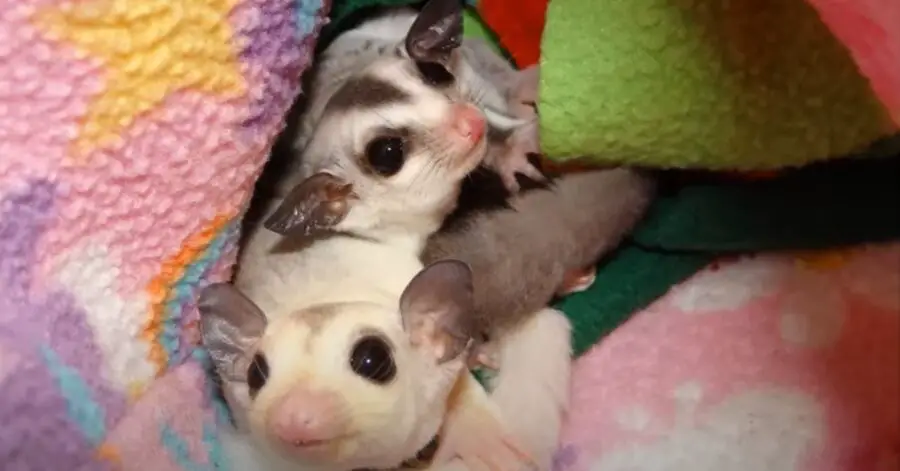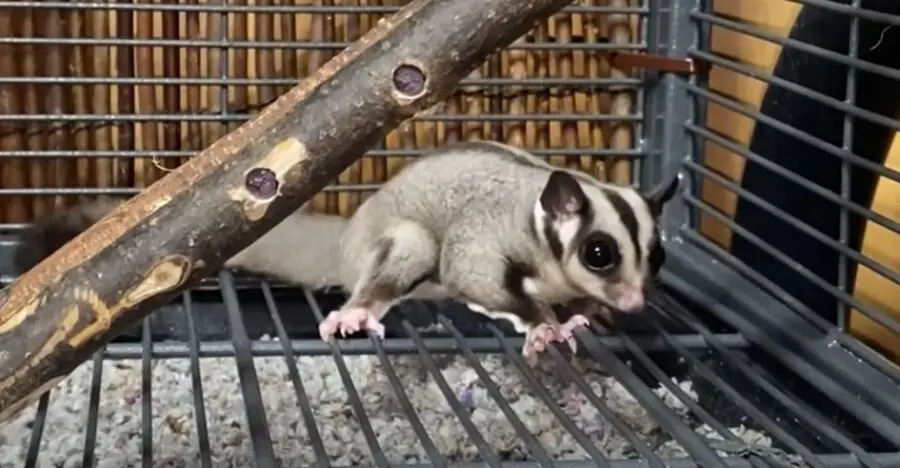Are you thinking about temperatures becoming too cold for your sugar glider? Do sugar gliders get cold easily?
We have experience with this and wish to offer top strategies to help you make sure that your sugar glider is comfortable.
This article is dedicated to the warmth of your sugar glider in your care. Please check it out.
Do Sugar Gliders Get Cold Easily?
Yes. We noticed that our sugar gliders avoid drafty areas, direct sunlight and enjoy their warm pouches throughout the year. When they get cold, they can easily become torpid, unresponsive, inactive and difficult to interact with.
Sugar gliders and more comfortable and warmer conditions around 80°F – 88°F (27°C – 31°C). Their core body temperature rests near 97°F (36°C). If they are consistently under a temperature falling to 50°F (10°C) for too long, it can lead to sudden death.

How Do I Tell if My Sugar Glider Is Cold?
A cold sugar glider will become unresponsive, curled up in a ball or cuddle with their cagemate throughout much of the day and night. They may eat less than usual or enter a torpid state.
They will be difficult to rouse and dehydration can also result. A lowering of their body temperature could lead to their immune system being compromised. This makes way for bacterial, fungal or respiratory infections.
Make sure the location that your sugar glider resides in is not receiving a flow of air from vents or draft coming from windows and doors. We have tried placing a heat pad under their enclosure, but we avoided using heat lamps because of their added risks.
Overall, our sugar glider has become much more comfortable with a pouch that we purchased and placed high up in her cage where she spends most of the time in the day remaining warm and comfortable.
Does getting cold cause sugar gliders to go bald? You should take a quick look to double check on this with the information I found here.
Are Sugar Gliders Sensitive to Temperature Changes?
Yes. One of the toughest challenges for taking care of sugar gliders is maintaining a warm temperature that is consistent throughout the year.
These are warm weather marsupials who also want to avoid direct sunlight. They would be comfortable in temperatures that are slightly higher than what we are used to in our homes. 80°F – 88°F (27°C – 31°C) would be a nice temperature for them but too hot for us.
Room temperatures at 65-75°F, is completely fine because you’re also offering your sugar glider extra warmth in the enclosure by way of a sugar glider pouch or sleeping pouch which we know they love and feel comfortable inside.

Can Sugar Gliders Catch a Cold?
Yes. We’ve heard of an issue where one of the members in our sugar glider community reported that his little marsupial was experiencing a runny nose with watery eyes.
He told us his sugar glider was making sneezing and sniffling noises as well. It sounded like he had a cold. We were very intrigued and wanted to know more about what happened after he visited the vet.
He was administered antibiotics which cleared up the symptoms. We don’t think that it’s very common for sugar gliders to experience cold or flu symptoms that are common with humans.
What we do know is that they can get cold easily and their body temperature drops leaving their immune system to be compromised. We have always been advised to keep our sugar glider away from drafty areas and be careful when temperatures become lower than 70°F.
Their immune system dropping makes them more susceptible to parasites as well. See if they can get fleas right here.
How to Keep Sugar Gliders Warm
Did you get a sugar glider sleeping pouch yet? It mimics what their mothers did for them when they were young. Now your sugar glider needs to stay warm over the winter and throughout the year where temperatures can change due to fluctuations.
- Be careful of air conditioning vents in warmer months. Some rooms are colder than others.
- Make sure that your sugar glider is kept in a room where the thermostat reads temperatures over 65 degrees Fahrenheit.
- Keep the enclosure warmer with a heat pad underneath it, or a warm pouch inside.
- An oil heater can be used near the cage and they are not as dry as space heaters.
- Other portable heaters needs to be kept further away because the dry air can lead to other types of respiratory or skin problems.
- Sugar gliders with a companion can use each other to stay warm.
- What we do is put a heating pad in a separate compartment of the heating pouch.
- We also use heat rocks in the past because they are safer than using heat lamps that has the risk of electric shocks.
- Heating gels work well, but only temporarily. The downside to using a heating gel is that it will cool overnight and will not retain its warm temperature.
- Finally, what works for us and our sugar glider is anti-pilled fleece blankets.
The reason why we choose anti pilled fleece is because they cannot pull away at the fibers and risk ingestion. These types of blankets are also recommended for other pocket pets such as guinea pigs and chinchillas.

Do Sugar Gliders Need a Heating Pad?
In our experience putting a heating pad underneath their cage has provided a safe source of extra heat for sugar glider during colder days. We found it to be a better method than using heat rocks or heat gels that cool much quicker than the heating pads.
Some heating pads are electric and you have to make sure that the wires do not get anywhere near your sugar glider. This is why putting it underneath the cage is the best idea.
Some heat pads can slide into the pouch of your sugar glider and provide a temporary source of heat on very cold days.
Do Sugar Gliders Keep Each Other Warm?
Yes. Unfortunately, we don’t have enough space to keep two sugar gliders together at the moment. You can notice that sugar gliders in the wild cuddle together to remain warm during colder temperatures.
A companion for your sugar glider is a very good idea to keep them warm, regulate their temperature as they would in the wild. It is up to you to decide whether or not this is the best course of action, but make sure that you have a budget set for a larger enclosure, more chew toys, bowls, bottles and food.
Thank you for visiting PocketPetCentral.com for the best information to help you enjoy the life of your pocket pet companion in a fun, safe & healthy way.


